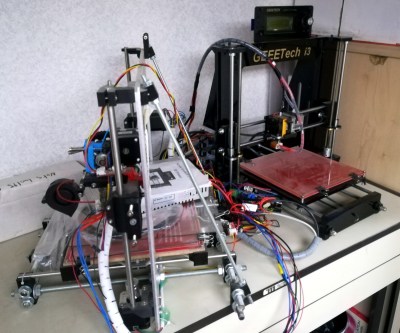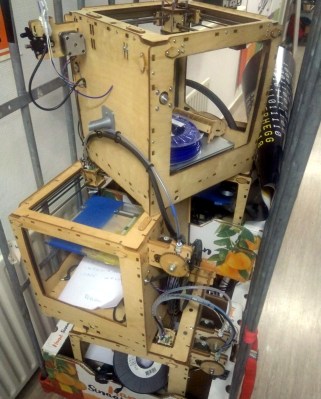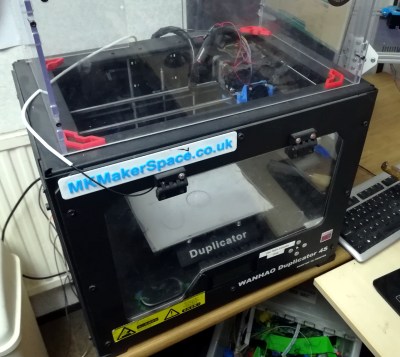One thing we sometimes forget in our community is that many of the tecniques and machines that we take for granted are still something close to black magic for many outsiders. Here’s a tip: leave a 3D printer running next time you take a group of visitors round a hackerspace, and watch their reaction as a Benchy slowly emerges from the moving extruder. To us it’s part of the scenery, but to them it’s impossibly futuristic and their minds are blown.

Nearly 15 years after the dawn of the RepRap project we have seen a huge advancement in the capabilities of affordable 3D printers, and now a relatively low three-figure sum will secure a machine from China that will churn out prints whose quality would amaze those early builders. We’ve reached the point in our community at which many people are on their third or fourth printer, and this has brought with it an unexpected side-effect. Where once a hackerspace might have had a single highly prized 3D printer, now it’s not unusual to find a pile of surplus older printers on a shelf. My hackerspaces both have several, and it’s a sight I’ve frequently seen on my travels around others. Perhaps it’s a sign of a technology maturing when it becomes ewaste, and thus it seems affordable 3D printing has matured.
Printer History Told Through The Medium Of Junk Piles

You can tell a lot about a product by how long it remains in use, for example a much higher percentage of Volkswagen Golfs have survived for three decades than have Yugo 55s. Thus a look at these piles of old printers is to look at which models turned out to be the stars and which the lemons. There are several main strands among them, each one representing a different set of failed dreams. First among them are the pioneers, a Makerbot Cupcake or perhaps a RepRap Darwin or Mendel. We even know of one space with a working Cupcake, but these aren’t machines you would use in 2019. Instead they represent the days when 3D printing was still a novelty even to us. If you think of the first machine you saw, perhaps it will be here.
Then there are the surprises, decent workhorses in their day that could still deliver a creditable result but which have simply been bypassed. It was a shock earlier in the year to see a pile of Ultimakers lying idle for instance, but perhaps I needed reminding that it was no longer 2015.
By far the most numerous though are the next group, knock-offs, proving that merely selling something as a Prusa clone does not make it a Prusa. It’s interesting though that not all clones were of low quality, I can think of more than one space still happily using years-old WanHao Duplicators, clones of the Makerbot Replicator.
Finally it’s a constant among hackerspaces that someone will have bought a delta printer and inevitably found it to be problematic. Is it a desire to be different or merely a fondness for printing vases that drives it, but if I had to guess which printer would be gathering dust it would be someone’s delta project.
What Can You Do with all This Junk?
So we’ve exposed a typical hackerspace junk pile as a potted history of failed desktop 3D printing endeavour, but as well as that it’s both a significant problem and an opportunity. A problem because while it has become a matter of ewaste the 3D printers themselves are still perceived as having value — but value that can only be realized if they do something other than sit on a junk pile. An opportunity because they still contain the basis of a CNC machine that is sitting idle.
If we can rid ourselves of the view that an old 3D printer is sacrosanct then we can make something of them, turn them into the basis of something else. We’ve all at times amassed piles of junk before realising that we’ve made a mistake, so there’s no shame in taking a fresh look at that printer pile.

At its most basic, a redundant 3D printer is a pile of parts just waiting to be dismantled. Slides, stepper motors, extrusions, and the associated electronics. It’s questionable whether whatever was the cutting edge in extruders and control boards circa 2012 could find a use in 2019, but the rest should find ready homes in other projects. To dismantle a printer though is perhaps to lose sight of its main event. A ready-made CNC mechanism with generous X, Y, and Z axes and a ready-to-go controller should be something that presents endless possibilities.
Attaching a mini router or an engraving laser to it is something of a done deal, but what else could you do? Make chocolate and fondant extruders with syringes and servos, and print confectionery? Attach an LED for some 3D-light painting? One-off art project or wacky tool, how have you repurposed your disused printer to keep it from gathering dust.
Whatever you think of for your surplus 3D printers, perhaps in all this there’s another story. Our community didn’t invent the 3D printer, but we’ve certainly taken it as our own and run with it. If we’ve reached the point at which they have finally matured, then in part that success belongs to us, to those hackers who have pushed forward their design. We can feel proud of that pile of surplus older printers, because they and the $200 Chinese machine that replaced them represent a 15-year success story from our community. The question is, where will they go in the next 15 years?
No comments:
Post a Comment